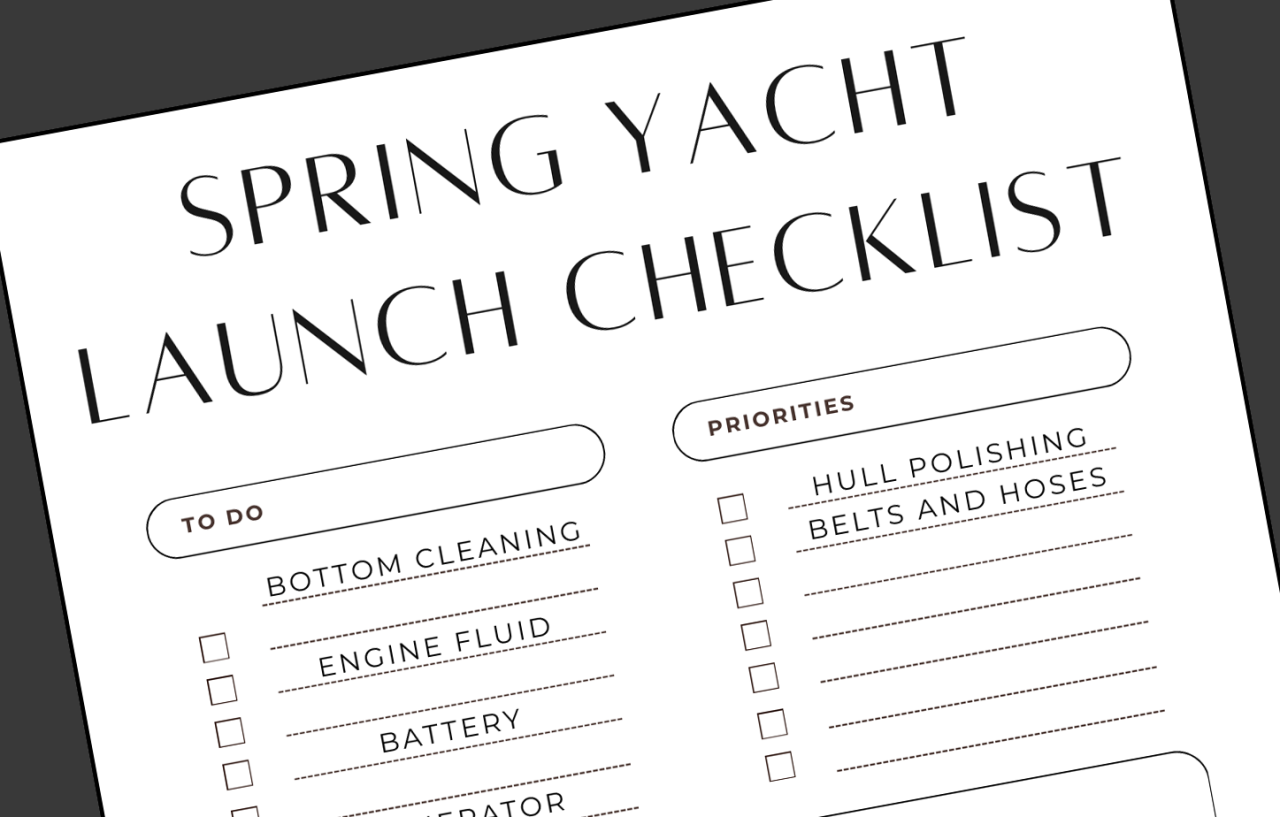Spring Yacht Launch Checklist: Preparing Your Vessel for the Season
The arrival of spring signals the exciting time to prepare your yacht for launch. After months in storage, your vessel requires thorough attention before hitting the water. This comprehensive checklist ensures your yacht is seaworthy, safe, and ready for a season of enjoyable cruising.
- Hull Inspection: Examine for blisters, cracks, or damage that may have occurred during winter storage
- Bottom Cleaning: Remove old antifouling paint and apply new coating according to manufacturer specifications
- Zinc Anodes: Replace sacrificial anodes that are more than 50% deteriorated
- Hull Polishing: Clean and wax the topsides to protect against UV damage and saltwater
- Through-Hull Fittings: Check all underwater fittings and seacocks for proper operation
- Propeller and Shaft: Inspect for damage, corrosion, or marine growth; ensure proper alignment
- Engine Fluid Check: Change oil and filters; check coolant, transmission fluid, and hydraulic steering fluid
- Fuel System: Inspect fuel lines, connections, and tanks for leaks; replace fuel filters
- Belts and Hoses: Check for wear, proper tension, and secure connections
- Battery Maintenance: Clean terminals, check electrolyte levels, test capacity, and recharge
- Bilge Pumps: Test all pumps for proper operation, clean intakes, and check float switches
- Thrusters: Test bow and stern thrusters for proper operation
- Generator Service: Change oil, filters, and perform manufacturer-recommended maintenance
- Shore Power: Inspect cords, plugs, and inlets for damage or corrosion
- Navigation Lights: Verify all running lights function properly
- Electronics Testing: Check radar, GPS, depth sounder, VHF radio, and other navigation equipment
- Circuit Testing: Verify all onboard circuits are operational
- Battery Charger: Confirm proper operation and charging rates
- Inverter: Test and inspect connections
- Freshwater System: Clean and sanitize tanks, check pump operation
- Water Heater: Inspect anode rod, check relief valve, and test operation
- Marine Toilets: Service and check for proper operation
- Holding Tanks: Clean and add treatment chemicals
- Shower Sumps: Clean and test pumps
- Seacocks and Strainers: Open all seacocks, clean strainers, and check for proper operation
- Life Jackets: Inspect for wear, ensure proper quantity for vessel capacity
- Fire Extinguishers: Check pressure gauges and certification dates
- Flares and Visual Distress Signals: Verify expiration dates and replace as needed
- First Aid Kit: Restock and check expiration dates on medications
- EPIRB: Test and verify registration information
- CO and Smoke Detectors: Test operation and replace batteries
- Throwable Flotation Devices: Inspect for damage and proper placement
- Upholstery and Cushions: Clean and inspect for mold or mildew
- Galley Appliances: Test refrigeration, stove, microwave, and other appliances
- Climate Control: Service air conditioning and heating systems
- Entertainment Systems: Test TV, stereo, and other entertainment equipment
- Lockers and Storage: Clean and organize all storage areas
- Standing Rigging: Inspect all wire, turnbuckles, and chainplates for wear or damage
- Running Rigging: Check halyards, sheets, and other lines for chafe or damage
- Winches: Clean, lubricate, and test operation
- Sails: Inspect for damage, clean as needed, and ensure proper storage when not in use
- Furling Systems: Test and lubricate all furling equipment
- Registration: Ensure vessel registration is current and properly displayed
- Insurance: Verify policy is active and coverage meets your needs
- Safety Inspection: Schedule professional safety inspection if required
- Charts and Navigation Tools: Update electronic charts and replace outdated paper charts
- Emergency Contact List: Update and post in a visible location
- Drain Plugs: Install all drain plugs before launching
- Engine Start: Start engine on land if possible to verify operation
- Seacock Closures: Ensure all unnecessary seacocks are closed
- Cradle or Jack Stands: Coordinate removal with yard staff
- Launch Schedule: Confirm launch date and time with boatyard
- Engine and Systems Check: Verify cooling water circulation and proper operation under load
- Leak Inspection: Check the entire vessel for leaks, especially around through-hulls
- Steering System: Test full range of motion and responsiveness
- Dock Lines and Fenders: Set up properly for your slip or mooring
By methodically working through this checklist, you'll ensure your yacht is properly prepared for a safe and enjoyable boating season. Regular maintenance not only enhances your vessel's performance but also preserves its value and extends its lifespan.
Remember that while this list is comprehensive, each yacht has unique requirements. Always consult your owner's manual for manufacturer-specific recommendations and consider professional servicing for complex systems.
Happy Boating!
Stay Informed
When you subscribe to the blog, we will send you an e-mail when there are new updates on the site so you wouldn't miss them.


Comments